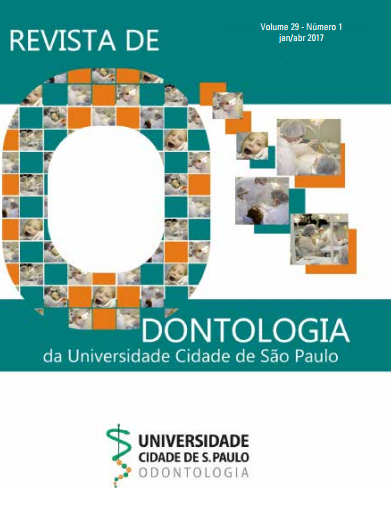Antimicrobial activity of different dental cements on aggregatibacter actinomycetemcomitans
DOI:
https://doi.org/10.26843/ro_unicid.v29i1.195Palavras-chave:
Periodontium, Dental Cements, Periodontal DiseasesResumo
Objectives: The objective of this study was to evaluate, in vitro, the possible antimicrobial activity against the A actinomycetemcomytans of three dental cements: glass-ionomer cement, zinc phosphate cement and resin cement. Material and Methods: Strains of A actinomycetemcomitans ATCC 29522 were used. The microorganism was grown in BHI Agar and transferred to tubes containing sterile saline solution. The suspension was calibrated to a similar turbidity to the 0.5 tube from McFarland scale. A base layer consisting of 20 ml of BHI agar was placed in sterile Petri 90 x 15 mm plates. After solidification, was added 0,1 uL of microbial suspension, and three wells with 6 mm in diameter and 1mm deep were made, the wells were filled with cements with zinc phosphate cement, glass-ionomer cement and resin cement indicated for permanent cementation for fixed prostheses immediately after handling and positive (chlorhexidine) and negative (saline) controls. Results: After 48 hours the presence or absence of inhibition halo of microbial growth was analyzed around the specimens. Conclusion: Zinc phosphate cement and glass ionomer cement tested showed antibacterial activity against A actinomycetemcomitans unlike resin cement.Downloads
Referências
Gasparetto A, Aarna-Chavez VE, Avila-Campos MJ. Aderência de Actinobacillus actinomycetemcomitans às células epiteliais bucais: estabilidade e aspectos ultra-estruturais. Pesquisa Odontológica Brasileira. 2000;14(4):311-8.
Nakagawa RI, Guazeli-Amin VH, Hidalgo MM, Trevisan Jr. W, Itano EN. Anticorpos antileucotoxina contra Actinobacillus actinomycetemcomitans em amostras de soro e saliva de pacientes com periodontite juvenil localizada. Pesquisa Odontológica Brasileira. 2001;15(1):05-11.
Tan KS, Song KP, Ong G. Cytolethal distending toxin of Actinobacillus actinomycetemcomitans. Occurrence and association with periodontal disease. Journal of periodontal research. 2002;37(4):268-72.
Van Hoogmoed CG, Geertsema-Doornbusch GI, Teughels W, Quirynen M, Busscher HJ, Van der Mei HC. Reduction of periodontal pathogens adhesion by antagonistic strains. Oral microbiology and immunology. 2008;23(1):43- 8.
Fine DH, Markowitz K, Fairlie K, Tischio-Bereski D, Ferrendiz J, Furgang D, et al. A consortium of Aggregatibacter actinomycetemcomitans, Streptococcus parasanguinis, and Filifactor alocis is present in sites prior to bone loss in a longitudinal study of localized aggressive periodontitis. Journal of clinical microbiology. 2013;51(9):2850-61.
Avila-Campos MJ, Simionato MRL, Cai S, Mayer MPA, De Lorenzo JL, Zelante F. Virulence factors of Actinobacillus actinomycetemcomitans: other putative factors. Pesquisa Odontológica Brasileira. 2000;14(1):05-11. REFER? NCIAS
Lima FLd, Farias FFd, Campos PC, Totola AH, Tavares CAP, Costa JEd, et al. Leukotoxic activity of Actinobacillus actinomycetemcomitans isolated from human and non-human primates. Brazilian Journal of Microbiology. 2001;32(3):250-6.
Yang HW, Huang YF, Chan Y, Chou MY. Relationship of Actinobacillus actinomycetemcomitans serotypes to periodontal condition: prevalence and proportions in subgingival plaque. European journal of oral sciences. 2005;113(1):28-33.
Faveri M, Figueiredo LC, Duarte PM, Mestnik MJ, Mayer MP, Feres M. Microbiological profile of untreated subjects with localized aggressive periodontitis. Journal of clinical periodontology. 2009;36(9):739-49.
Sanz M, Quirynen M. Advances in the aetiology of periodontitis. Group A consensus report of the 5th European Workshop in Periodontology. Journal of clinical periodontology. 2005;32 Suppl 6:54-6.
Flemmig TF, Sorensen JA, Newman MG, Nachnani S. Gingival enhancement in fixed prosthodontics. Part II: Microbiologic findings. The Journal of prosthetic dentistry. 1991;65(3):365- 72.
Loe H, Theilade E, Jensen SB. Experimental gingivitis in man. The Journal of periodontology. 1965;36:177-87.
Newman MG, Socransky SS, Savitt ED, Propas DA, Crawford A. Studies of the microbiology of periodontosis. The Journal of periodontology. 1976;47(7):373-9.
Lang NP. Commentary: bacteria play a critical role in the etiology of periodontal disease. The Journal of periodontology. 2014;85(2):211-3.
Albandar JM. Aggressive periodontitis: case definition and diagnostic criteria. Periodontology 2000. 2014;65(1):13- 26.
Klai S, Altenburger M, Spitzmuller B, Anderson A, Hellwig E, Al-Ahmad A. Antimicrobial effects of dental luting glass ionomer cements on Streptococcus mutans. TheScientificWorldJournal. 2014;2014:807086.
Orstavik D, Hensten-Pettersen A. Antibacterial activity of tooth-colored dental restorative materials. Journal of dental research. 1978;57(2):171-4.
Qvist J, Qvist V, Lambjerg-Hansen H. Bacteria in cavities beneath intermediary base materials. Scandinavian journal of dental research. 1977;85(5):313-9.
Scherer W, Lippman N, Kaim J. Antimicrobial properties of glass-ionomer cements and other restorative materials. Operative dentistry. 1989;14(2):77-81.
DeSchepper EJ, White RR, von der Lehr W. Antibacterial effects of glass ionomers. American journal of dentistry. 1989;2(2):51-6.

